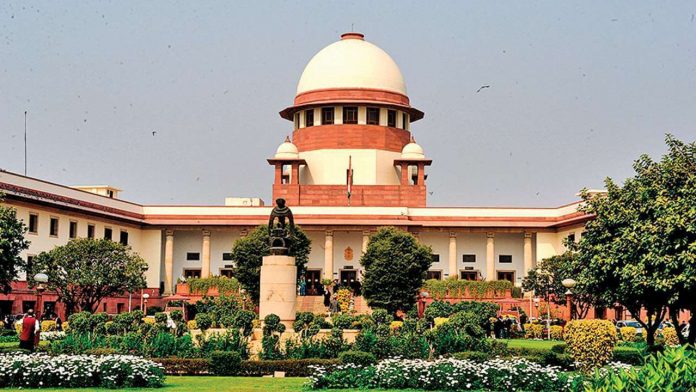This article is written by Anurag Singh from ILS Law College, Pune. This is a comprehensive article that critically analyses UAPA in the light of a recent judgment namely Union of India v. K.A. Najeeb.
Table of Contents
Introduction
Since the very inception of the human race, social ill practices or activities have always been present in society. Always the innocent are the ones that suffer the most, the essence of which can be understood in a quote by Howard Zinn – “How can you have a war on terrorism when war itself is terrorism?”. Therefore, to fight terrorism India has enacted not just one but seven laws namely;
- Preventive Detention Act, 1950;
- Armed Forces Special Power Act, 1958;
- Unlawful Activities Prevention Act, 1967;
- Maintenance of Internal Security Act, 1971;
- National Security Act, 1980;
- Terrorist and Disruptive Act, 1987;
- Prevention of Terrorism Act, 2002.
Some of these Acts still to this day are active and some of them have been repealed. The one which we are going to talk about in this article is the Unlawful Activities Prevention Act, 1967 (hereafter referred to as UAPA).
Unlawful Activities Prevention Act, 1967
History
The founder of Dravida Munnetra Kazhagam and former chief minister of Tamil Nadu, CN Annadurai way back in 1962 demanded a separate Tamil country when India was under tremendous external pressure from China during the Indo-China war. Even though he did not move forward with the ideology of a separate country. Consequently, the central government realized that there is a need to restrict the freedom of the citizens to maintain peace and harmony within the country.
Subsequently, the National Integration Council formed a committee for national integration and regionalization within the country. On the recommendation of this very committee, the 16th Amendment Act came into existence, wherein ‘reasonable restriction’ was imposed on three essential fundamental rights, i.e freedom of speech and expression, right to assemble, and right to form association & unions. This gave birth to a new Act, the Unlawful Activities Prevention Act, 1967 which was passed right after this amendment.
Objective
As the name suggests UAPA was enacted to prevent unlawful activities within the country. Let’s understand what ‘unlawful activity’ means under the ambits of this Act. In very simple words it means that actions, done by any organization or any individual with the intent to bring cession or separation or to disrupt the sovereignty or territorial integrity.
Timeline of Amendments
This Act was there in place since 1967 but the government felt the need to make its first amendment in 2004 as Terrorist and Activity Prevention Act, 1987 (TADA) and Prevention of Terrorism Act, 2002 (POTA) both were repealed in 1995 and 2004 respectively.
Subsequently, there was a dire need for terrorism laws. Therefore, a dedicated chapter was introduced defining ‘Terrorist activities’ (chapter IV) in the amendment of 2004. After that, there had been only three amendments made to the Act, in 2008, 2013, and 2019, which is the latest addition to the amendments.
The recent amendment was the most controversial and debatable amendment of all of them. Amendments were made regarding the detention of the individual or organization. Under the new amendment any person, that has been charged under UAPA, can be detained without any charge sheet for 180 days. Moreover, an extension can be requested but, until this period is over the ‘right to bail’ of an individual does not arise. Let’s understand whether UAPA is arbitrary or not via a landmark judgment given by the Supreme court on 1st February, 2021.
Union of India v. K.A. Najeeb
Facts
- K.A Najeeb (hereinafter referred to as the respondent), the main accused in the case, was an active member of a Radical organization called the Popular Front of India (PFI).
- T.J. Joseph, the victim, was a professor at Newman College, Thodupuzha.
- The respondent in the present case found a question framed by the victim objectionable and was of the view that the particular question was targeted towards a particular religion deliberately.
- Therefore, to avenge their religious beliefs, the respondent along with other members of the organization planned an attack on the victim.
- The members of PFI on 4th July 2010 attacked the victim while he was returning home with his mother and sister. For just a petty issue involving an objectionable question, they retaliated by chopping off the right palm of the victim with choppers, axes, and knives.
- They did not just threaten the victim but also threw country-made bombs at bystanders so that they didn’t dare help the victim.
- Subsequently, the FIR was lodged against the attackers and after the investigation concluded, it led the National Investigation Agency (NIA) to believe that it was a conspiracy involving dangerous weapons therefore, UAPA should apply to all the offenders.
- All co-accused were sentenced to rigorous imprisonment between 2-8 years by the NIA special court. However, the respondent was declared fugitive. But, was eventually found and was kept under judicial custody for 5 years.
- In his time in jail, the respondent applied for bail many times but was rejected by the NIA special court all the time because there was prima facie evidence against the respondent. Moreover, under Section 43D(5) he was not eligible for bail, furthermore, under UAPA, the normal rules of bail do not apply.
- Frustrated by his NIA special court efforts, the respondent decided to apply for bail in the High Court. The court set aside the impugned order by the NIA special court and granted the respondent bail. The court believed that the trial was going on for too long without any conclusion.
- Consequently, an appeal was filed by NIA stating that the bail granted by the court was flawed. Hence, this case.
Arguments
Arguments by Appellant
The Appellant argued that the bail granted to the respondent in the instant case is flawed as it does not align with Section 43(D)(5) of the UAPA.
It was highlighted by the counsel that the courts are bound to refuse the bails where the accused is prima facie guilty. It was further contended in the instant case that the fact that the respondent was a fugitive for years makes it more crystalline for the courts to not grant bail.
Lastly responding to the delay in the trial, the counsel in the instant case advanced an argument stating that NIA had filed an additional affidavit to examine 276 witnesses.
Arguments by Respondent
It was highlighted by the counsel of the respondent, that most of the co-accused have been either acquitted or have been sentenced to imprisonment for not more than 8 years.
Adding to the aforementioned point, the respondent had already been imprisoned for more than 5 years, which is constitutionally violative within the ambits of equal access to justice and right to a speedy trial, which is laid down in Part III of the Constitution.
Furthermore, the counsel for the respondent advanced an argument stating that if the High Court in a matter has granted bail to the accused then the Supreme Court should not interfere unless in a rare circumstance.
Lastly, it was contested that the right to liberty and freedom was violated in the present case by keeping the accused in custody without any trial.
Issues
The aforementioned case tackled three major issues, that are mentioned below:
- Whether a violation of Article 21 can oust the statutory rigours under Section 43D(5) of UAPA?
- Whether the court is duty-bound to deny bail where the suspect is prima facie believed to be guilty?
- Whether the court’s decision to grant bail can be challenged without any special grounds?
Opinion of the Court
The Supreme Court held that even though the accused has been found prima facie guilty by the NIA and there is a provision under Section 43D(5) of UAPA to deny bail. However, the courts can grant bail if the provisions under any laws are violating the constitutional rights of the accused, and in the present case by the facts put forth, it was crystal clear to the Hon’ble Supreme court that the ‘right to speedy trial’ has been violated. Moreover, the fact that it is unlikely for the trial to complete anytime soon.
Furthermore, Section 43(d)(5) has no precondition to restrict the accused to commit another crime, and it is just another provision to deny the bail. Therefore, the Supreme court concluded by upholding the decision of the High court and also found the special leave petition unmaintainable.
Critical analysis of UAPA in light of Union of India v. K.A. Najeeb
UAPA was a legislation that was enacted initially to ease the burden on the criminal justice system of India, but it received heavy criticism for the act being arbitrary after the amendments to the Act were enacted.
It is not out of place to state here that Section 43(D)(5) of UAPA is under major scrutiny, as it gives special authorization to the NIA special court to deny bail if deemed necessary. What is pertinent here is that the word ‘necessary’ has neither been defined by the Act nor by any judgment. Therefore, this Section can be misused by the investigating authorities. The instant case where the accused was denied bail several times by NIA special court before getting it from the High Court can also be seen.
According to the National Crime Records Bureau (NCRB) data, of all the accused arrested under the UAPA, only 2.2 percent end up being convicted by the courts. Therefore, keeping the accused in custody for a longer duration can seem questionable. However, a clear nexus can be drawn between longer custody and constitutional rights. It was crystal clear in the instant case as well, the accused violated his constitutional rights by keeping the accused in jail for more than five years without any trial. It was also observed by the Supreme Court and the accused was subsequently granted bail
Conclusion
Unlawful Activities Prevention Act, 1967 was enacted to help the government to put an end to increasing terrorist activities and ease off the load from the criminal justice system. Looking at such cases, it will be safe to say that along with curbing the terrorist activities, UAPA has been violating the constitutional rights of the individual which can’t be taken away from the citizen when there is an ‘emergency’ in the country. The government should aim to strike a balance between stringent laws and constitutional rights so that the people instead of feeling threatened, feel empowered.
References
- https://www.firstpost.com/india/uapa-amendment-bill-2019-violates-the-very-international-laws-it-quotes-defies-principles-of-natural-justice-7104391.html
- https://www.lawctopus.com/academike/case-uoi-v-najeeb/
- https://www.youtube.com/watch?v=1fPMyvpbvbA
- https://www.indiacode.nic.in/handle/123456789/1470
- https://www.latestlaws.com/latest-ne;ws/sc-a-statutory-restriction-like-section-43d-5-of-uapa-does-not-oust-the-ability-of-constitutional-courts-to-grant-bail-on-grounds-of-violation-of-fundamental-rights-read-judgment/
LawSikho has created a telegram group for exchanging legal knowledge, referrals, and various opportunities. You can click on this link and join:
 Serato DJ Crack 2025Serato DJ PRO Crack
Serato DJ Crack 2025Serato DJ PRO Crack











 Allow notifications
Allow notifications



